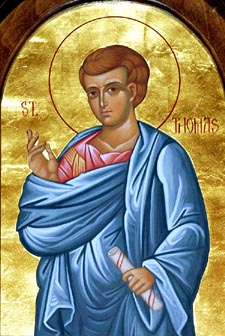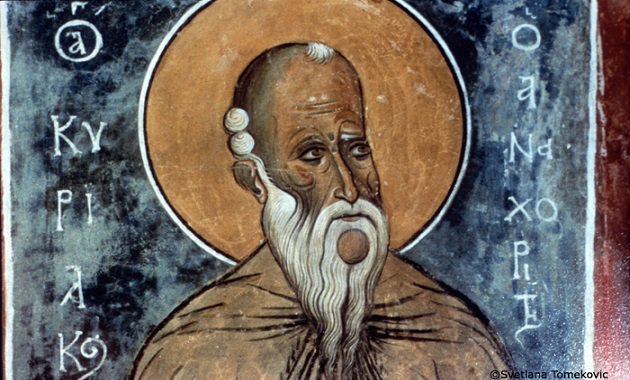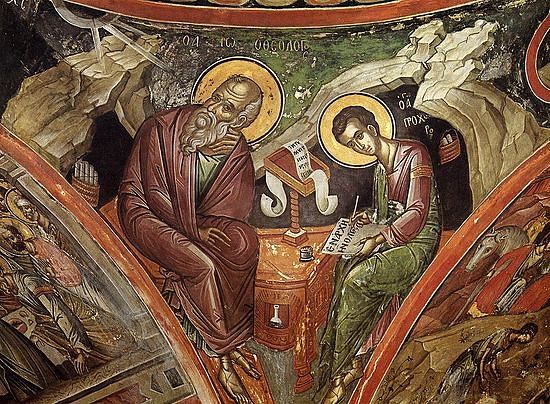Science
Holy, Glorious Apostle Thomas
19. October 2017 - 9:06 The Holy and Glorious Apostle Thomas was born in the Galilean city of Pansada and was a fisherman. Hearing the good tidings of Jesus Christ, he left all and followed after Him. The Apostle Thomas is included in the number of the holy Twelve Apostles of the Savior.
The Holy and Glorious Apostle Thomas was born in the Galilean city of Pansada and was a fisherman. Hearing the good tidings of Jesus Christ, he left all and followed after Him. The Apostle Thomas is included in the number of the holy Twelve Apostles of the Savior.
According to Holy Scripture, the holy Apostle Thomas did not believe the reports of the other disciples about the Resurrection of Jesus Christ: “Unless I see in His hands the print of the nails, and put my finger into the print of the nails, and thrust my hand into His side, I will not believe” (John 20:25).
On the eighth day after the Resurrection, the Lord appeared to the Apostle Thomas and showed him His wounds. “My Lord and my God,” the Apostle cried out (John 20:28). “Thomas, being once weaker in faith than the other apostles,” says Saint John Chrysostom, “toiled through the grace of God more bravely, more zealously and tirelessly than them all, so that he went preaching over nearly all the earth, not fearing to proclaim the Word of God to savage nations.”
Venerable Cyriacus the Hermit of Palestine
12. October 2017 - 10:33 Saint Cyriacus was born at Corinth to the priest John and his wife Eudokia. Bishop Peter of Corinth, who was a relative, seeing that Cyriacus was growing up as a quiet and sensible child, made him a reader in church. Constant reading of the Holy Scriptures awakened in him a love for the Lord and of a yearning for a pure and saintly life.
Saint Cyriacus was born at Corinth to the priest John and his wife Eudokia. Bishop Peter of Corinth, who was a relative, seeing that Cyriacus was growing up as a quiet and sensible child, made him a reader in church. Constant reading of the Holy Scriptures awakened in him a love for the Lord and of a yearning for a pure and saintly life.
The Mystery of Theotokos in Byzantine Hymnography
10. October 2017 - 9:57Theotokology in Hymnography of St. John of Damascus
Bishop John (Puric), PhD
The name of the Virgin Mary is encountered not only in the Holy Scripture[1] and the Holy Tradition, but is mentioned in the entire life of the Orthodox Church: in divine worship, hymnography, iconography and music. Of special importance is the fact that the divine services of the Orthodox Church repeat the entire Theandric Economy of Salvation.[2]
Saint John the Theologian Preacher of Divine Love
9. October 2017 - 15:51 In the fall of 1962 or 1963, my husband and I arrived in Bad-Kissengen for a course of treatment at one of the sanatoriums. The following day I found my way to the Russian church, where I met the rector, Fr. Michael Zagoryansky. From the first moment of our acquaintance, this meek, amiable and kindly pastor became very dear to me. Our shared admiration for Vladika John (Maximovitch) undoubtedly contributed to this feeling of closeness.
In the fall of 1962 or 1963, my husband and I arrived in Bad-Kissengen for a course of treatment at one of the sanatoriums. The following day I found my way to the Russian church, where I met the rector, Fr. Michael Zagoryansky. From the first moment of our acquaintance, this meek, amiable and kindly pastor became very dear to me. Our shared admiration for Vladika John (Maximovitch) undoubtedly contributed to this feeling of closeness.
The Church’s Engagement With The World – Witnessing As The Church’s Method
8. October 2017 - 14:17~ By Jovan, Bishop of Nis
The complex, polymorphous and fluid problematics of the (“post-Christian”) present have presented the Church – the universal Body of Christ and us Christians, godlike personalities that are the reason-bearing limbs of that Body, with an unprecedented challenge[1] in the history of Christianity thus far, one that we cannot, even if we should wish to, ignore, overlook or suppress. As an answer to this dramatic challenge, we must offer a living and creative Christian answer – a personal-universal witnessing of the present Church generation, an answer articulated on the basis of the Church’s universal traditional experience and a personal experience of faith as our active inclusion in that universal experience, if we wish to fulfill Christ’s commandment – to be the salt of the earth and the light of the world (Mt 5:13, 14), to truly be Christians. Here we should immediately point out that the said word of Christ is not simply some spiritual or moral “suggestion” or “counsel” that may be situationally accepted or rejected by one’s own free will, but an explicit Divine commandment concerning an active witnessing of theandric salt and the light of Christ to all people and nations, and to all of creation, which God personally commands as a necessary precondition for us to be Christians at all, and to call ourselves Christian. The entire history of the Church, which is, in fact, nothing other than the history of its world – a world that she transformed, through Christ’s salt and light, into the Christian world, bears witness to the fact that there are no “Christians outside of the world,” nor is there a “world outside of the Church.” For, a theoretical concept and practice of Christianity by which, in abhorrance of the “sinful world,” Christians isolate themselves into some sort of self-satisfied and righteous “holy remnant” and “island of the saved,” is neither evangelical, nor ecclesiastical, nor Orthodox but, rather, “all too human,” “religious,” psychologizing, pietistic and utopian,[2] and, as such, foreign to the entire Living Tradition of Christ’s Orthodox Church. Precisely due to the fact that this Tradition, through the entire theology of the Fathers, has forever rejected any dualistic understanding of man and the world as being in opposition to the truth of the man of God and the world of God, along with any “religious” dualism, i.e., the introduction of dichotomous schisms and divisions[3] into God’s single creation (and, before all, divisions into “sacred and profane,” “spiritual and material,” “religious and secular,” with the first element of these dichotomous pairs being assigned to the sphere of “salvation,” and the second not only being forejudged as lost for being unclean and ephemeral, but also being consciously “left” to this fate).
Bishop Jovan Puric: The Orthodox Aesthetics in the Hagiography of St. Arsenius of Srem
6. October 2017 - 11:38Fresco painting depicting the burial service of St Arsenius
in The Patriarchate of Pec
An opening discussion for further research
At this historical moment of our struggle to keep Kosovo and Metohija within the boundaries of Serbia, and in the light of 1220th anniversary of 1st Ecumenical Council, it seems sensible to discuss the topic of burial services as presented on frescoes and icons in the Patriarchate of Pec. A new iconoclasm has been present in Kosovo and Metohija in the course of recent years. We have recently visited Pec, i.e. on the occasion of celebrating the Feast of Holy Protection of Тheotocos and once again experienced silent prayers of this sanctuary area, the See of Serbian Archbishops and Patriarchs; it is a sanctuary in wich holy relics of saints and icons speak a wordless language. The peace of the Sanctuary takes us into another dimension; it is witnessing of the one crying in the contemporary wilderness spreading the voice of the Truth.

